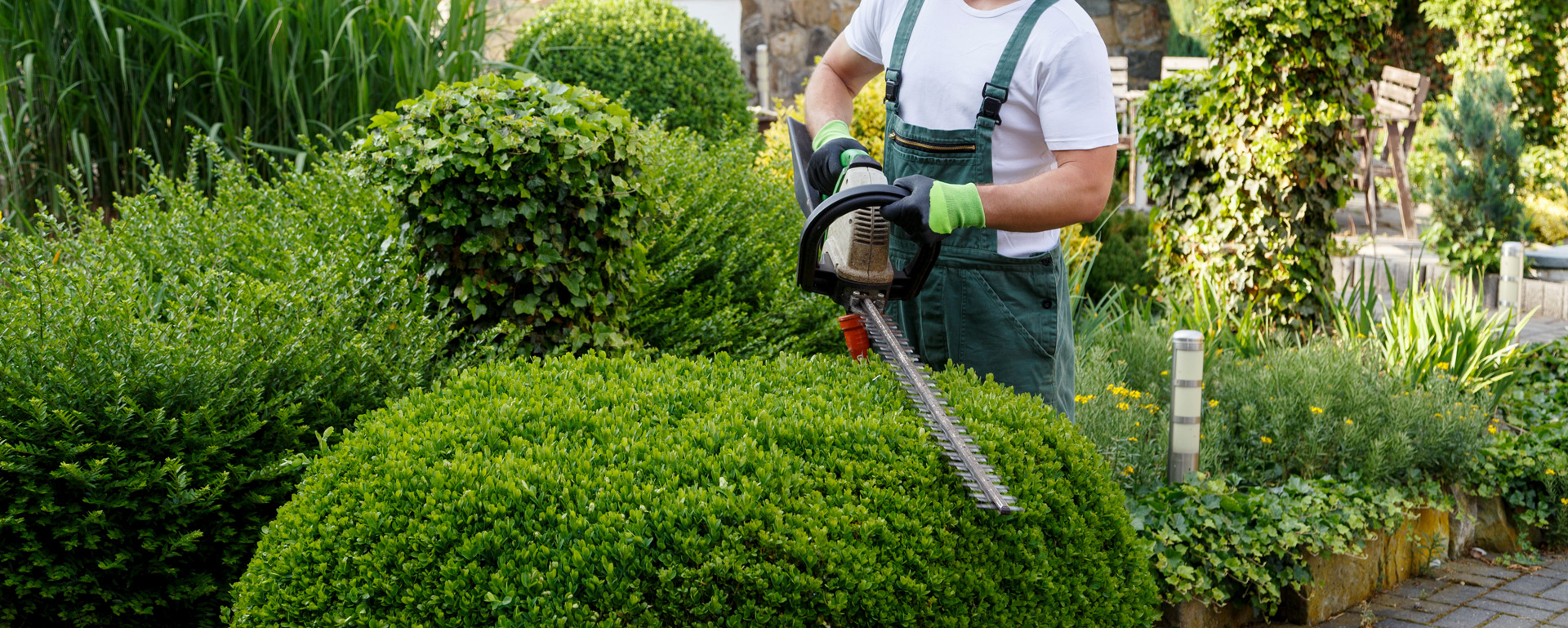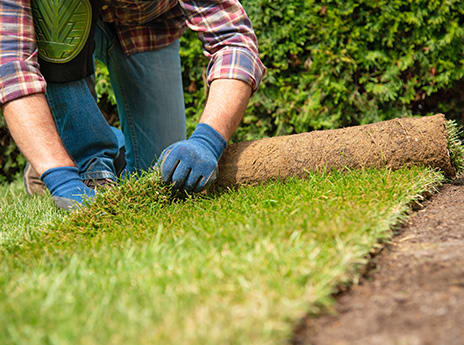Landscaping services FAQs: answers to your top outdoor questions
Wiki Article
Understanding the Comprehensive Range of Works in Specialist Landscape Design Services
The considerable scope of specialist landscaping services includes a selection of essential components. It includes landscape style principles, plant selection, and hardscaping features. Additionally, it attends to irrigation systems and upkeep strategies. Each facet plays an important function in producing useful and aesthetically pleasing exterior areas. Comprehending how these parts interact can reveal much about the art and science of landscape design. However, the trip right into this complex area is simply beginning.
Landscape Layout Principles
Reliable landscape style principles are essential for developing harmonious outside spaces that boost both visual charm and capability. These principles lead the plan of components within the landscape, making sure a natural aesthetic experience. Trick elements consist of equilibrium, which disperses visual weight equally; percentage, which connects the dimension of various components to each other and the area; and unity, which produces a feeling of integrity with constant motifs and products.
Furthermore, emphasis guides focus to focal points, while rhythm develops motion via repetition of layout attributes. The efficient usage of line can create pathways and guide the eye via the landscape. In addition, recognizing the site's topography, climate, and existing attributes is important for integration with the surrounding atmosphere. By adhering to these fundamental concepts, landscape developers can craft rooms that not just look appealing however likewise serve their desired purpose, enhancing the overall experience for customers.
Plant Selection and Setup
In the domain of professional landscaping, plant option and installation play a critical function in achieving a thriving garden - landscaping services. Highlighting native plant benefits, seasonal factors to consider, and the details soil and sunshine requirements of each species ensures a lasting and aesthetically pleasing landscape. Cautious planning in these locations not only boosts biodiversity but additionally advertises long-lasting environmental healthNative Plant Benefits
Why should homeowners consider native plants for their landscaping projects? Indigenous plants provide various benefits that enhance both aesthetics and ecological sustainability. They are well-adapted to regional environments, requiring much less water and upkeep compared to non-native varieties. This strength reduces the demand for chemical fertilizers and chemicals, advertising a much healthier ecological community. Furthermore, native plants give habitat and food for regional wild animals, including pollinators, which can enhance biodiversity in residential areas. Their experience with neighborhood dirt and climate condition likewise brings about much better growth prices and long life. By choosing native plants, house owners not only create aesthetically attractive landscapes yet likewise add to environmental preservation, making a favorable effect on their neighborhood atmosphere. Native plants stand for a clever choice for landscape design projects.Seasonal Plant Considerations
Home owners that have actually accepted native plants in their landscaping can additionally improve their exterior areas by taking into consideration seasonal plant selections. By integrating plants that prosper in details periods, they can develop vibrant and aesthetically appealing landscapes throughout the year. Spring may introduce vivid blossoms like daffodils and tulips, while summer can showcase lush foliage and vibrant perennials. Autumn presents a combination of cozy tones with goldenrods and asters, while winter months can be highlighted with evergreens and decorative turfs for structure. Specialist landscapers commonly recommend selecting plants that not just complement existing indigenous varieties yet likewise provide year-round interest and support neighborhood wildlife. This thoughtful technique to seasonal plant choice assures a constantly progressing and sustainable garden setting.Soil and Sunshine Needs
Effective landscaping depends upon comprehending the specific dirt and sunshine needs of plants. Various varieties prosper under varying conditions, requiring a mindful evaluation of both elements during the selection process (landscaping). Soil kinds, such as sandy, clay, or loamy, influence drain, nutrition availability, and origin advancement. Additionally, pH degrees can impact plant health, demanding dirt testing to determine viability. Sunlight needs differ considerably; some plants prosper completely sun, while others favor complete or partial color. A professional landscaper considers these components to guarantee peak development and aesthetic allure. By lining up plant choices with the setting's particular characteristics, landscapes can accomplish sustainability, resilience, and aesthetic consistency, ultimately bring about successful plant facility and long-term upkeepHardscaping Features and Construction
While landscape design typically stimulates photos of lush plant and dynamic blossoms, hardscaping features play a crucial duty in defining exterior spaces. These aspects, which include outdoor patios, walkways, preserving walls, and attractive stonework, supply framework and functionality to lawns and gardens. Hardscaping utilizes materials such as concrete, timber, stone, and brick, enabling varied styles that match the natural landscape.The construction of hardscaping features needs cautious preparation and implementation to ensure toughness and visual appeal. Professionals examine website conditions, water drainage, and spatial partnerships to produce cohesive outside settings. Appropriate setup methods are crucial, as they avoid problems like erosion and moving gradually.
Integrating hardscaping not just improves the aesthetic passion of a home but also helps with outdoor activities, making it an essential aspect of extensive landscaping services. Eventually, thoughtful hardscaping contributes to both the performance and elegance of outdoor spaces.
Irrigation Systems and Water Monitoring
Reliable watering systems and water management are essential parts of expert landscaping, as they guarantee that plants get the essential hydration for excellent development. These systems can differ from straightforward drip watering arrangements to advanced automated automatic sprinkler, designed to meet the specific demands of diverse landscapes. Proper water administration not just enhances water usage, lowering waste, however also boosts plant health and minimizes illness risks.Landscape design specialists evaluate numerous elements, consisting of soil kind, plant types, and regional environment, to establish tailored irrigation solutions. In addition, integrating rain harvesting techniques can better improve sustainability and performance (Read More). Normal upkeep of watering systems is important to keep capability and prevent leaks, which can bring about water loss and increased costs. Ultimately, a well-designed irrigation system plays a crucial function in maintaining the visual appeal of outdoor rooms while advertising environmental stewardship within professional landscape design practices
Lawn Care and Upkeep Approaches
Grass treatment and upkeep methods are essential for attaining a lavish, healthy and balanced backyard that improves the general landscape. These techniques incorporate various practices targeted at advertising ideal development and visual charm. Normal mowing is essential, as it urges thick, also growth while avoiding weeds from establishing. Furthermore, proper fertilizing supplies needed nutrients, with applications tailored to the certain turf kind and soil problems.Watering methods ought to concentrate on deep, infrequent watering to motivate origin growth, while oygenation enhances soil framework and advertises nutrition absorption. Insect and condition monitoring is also essential; identifying problems early enables efficient therapies that reduce damages.
Finally, overseeding can rejuvenate broken or thin grass, enhancing thickness and color (landscaping services). By applying these targeted lawn care techniques, landscaping specialists can guarantee that yards stay healthy and balanced and vivid throughout the seasons, significantly adding to the general beauty of the building
Seasonal Landscape Treatment and Upkeep
As the seasons modification, proper landscape treatment becomes vital for keeping the wellness and charm of outside spaces. Each period provides distinct obstacles and demands. In springtime, landscape experts concentrate on trimming, planting, and feeding to motivate development. Summertime demands normal watering, weed control, and insect administration to secure recently established plants.Autumn needs the prep work of yards for wintertime, including mulching, leaf elimination, and the growing of light bulbs for the next springtime. Furthermore, wintertime treatment entails shielding at risk plants from frost and guaranteeing that hardscapes are functional and safe.
Throughout the year, seasonal landscape maintenance assurances that outdoor locations stay visually attractive and healthy and balanced. Specialist services can provide customized maintenance plans that adjust to the particular requirements of each period, permitting homeowner to take pleasure in vibrant landscapes year-round. Overall, seasonal treatment is an important aspect of specialist landscape design that advertises durability and visual value.
Lasting Landscaping Practices
An expanding number of residential or commercial property owners are embracing sustainable landscape design techniques to create eco-friendly outdoor spaces. These practices concentrate on preserving resources, boosting biodiversity, and minimizing ecological effect. Native plants are usually picked for their reduced water needs and compatibility with neighborhood ecosystems, lowering the requirement for chemical fertilizers and pesticides. Rainfall gardens and absorptive paving are utilized to manage stormwater drainage, advertising groundwater recharge and reducing disintegration.In addition, sustainable landscape design incorporates natural gardening techniques that focus on soil health and advertise natural insect control. Effective irrigation systems, such as drip irrigation and rain harvesting, help maximize water use. Additionally, landscape developers progressively support for using recycled products, such as redeemed wood and stones, to lessen waste. By taking on these lasting methods, homeowner not only add to eco-friendly preservation however additionally produce cosmetically pleasing atmospheres that can love marginal maintenance.
Often Asked Questions
Exactly how Lengthy Does a Landscape Design Project Commonly Take to Total?
Typically, a landscaping job can take anywhere from a couple of days to several weeks to complete, depending upon the project's complexity, style, and dimension needs. Read More. Factors such as climate and source accessibility also affect timelinesWhat Aspects Influence the Cost of Landscape Design Services?
Different elements influence landscape design service prices, consisting of task dimension, design intricacy, material top quality, labor costs, geographic location, and seasonal need. Each aspect contributes distinctly to the general financial requirements of a landscape design project.Are Landscape Design Services Available Year-Round?
Landscape design services are typically offered year-round, although availability might differ based on area, seasonal climate condition, and particular solution offerings. Some services may be Going Here limited throughout extreme weather condition or off-peak seasons.Do Landscape Design Business Deal Guarantees on Their Job?

Can I Design My Landscape Without Professional Help?
Yes, individuals can create their landscapes without professional assistance. Nonetheless, they might lack expertise in plant selection, format, and environmental factors to consider, possibly leading to much less effective styles that can call for expensive adjustments later.
Report this wiki page